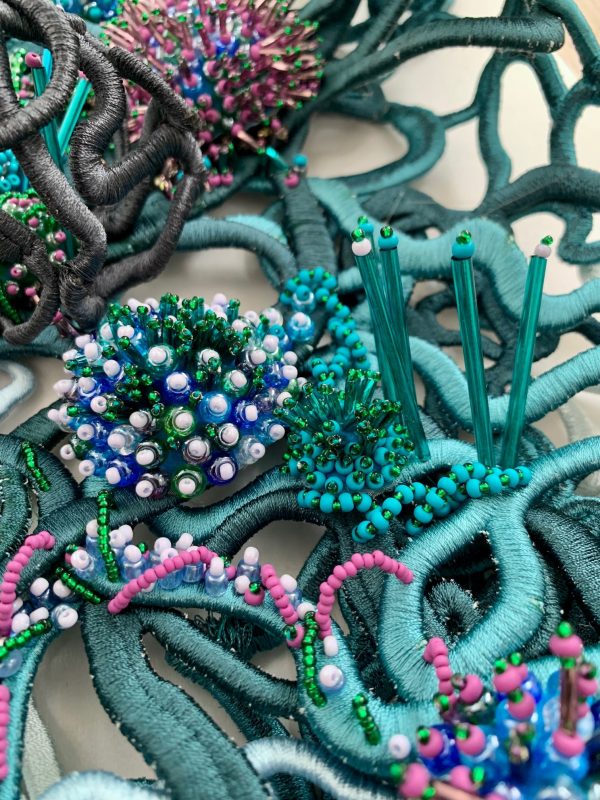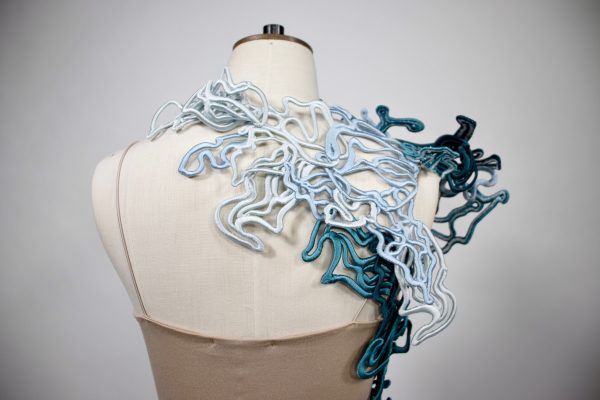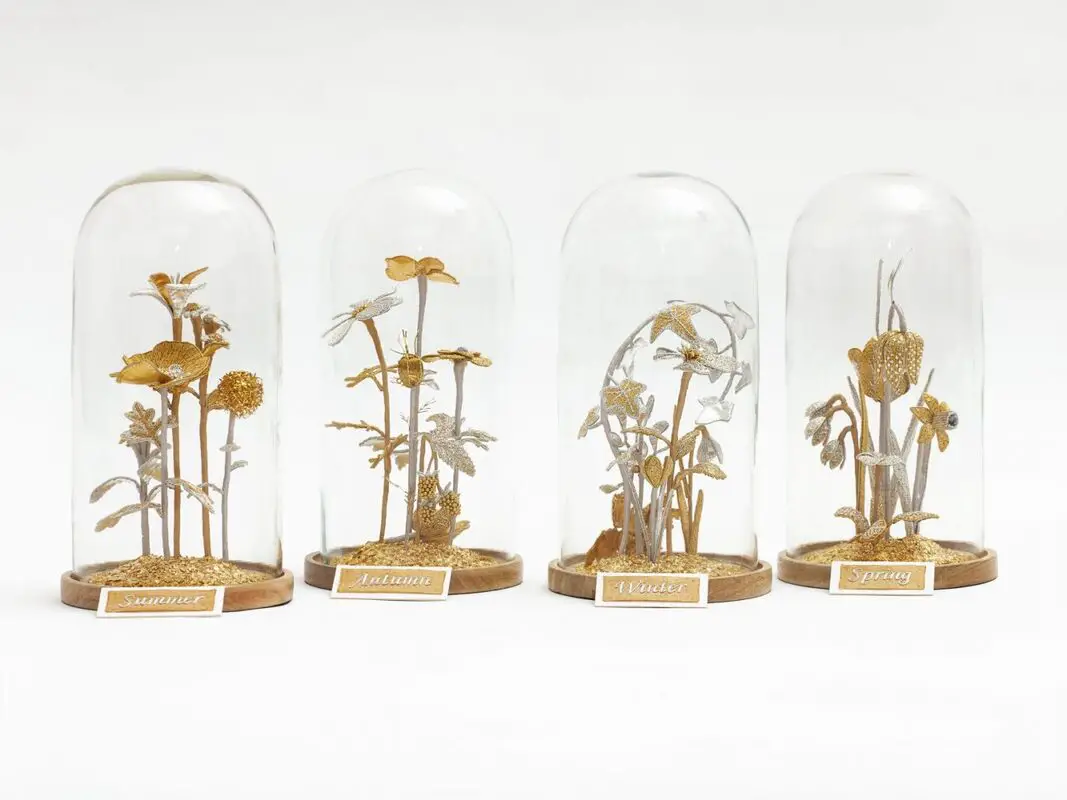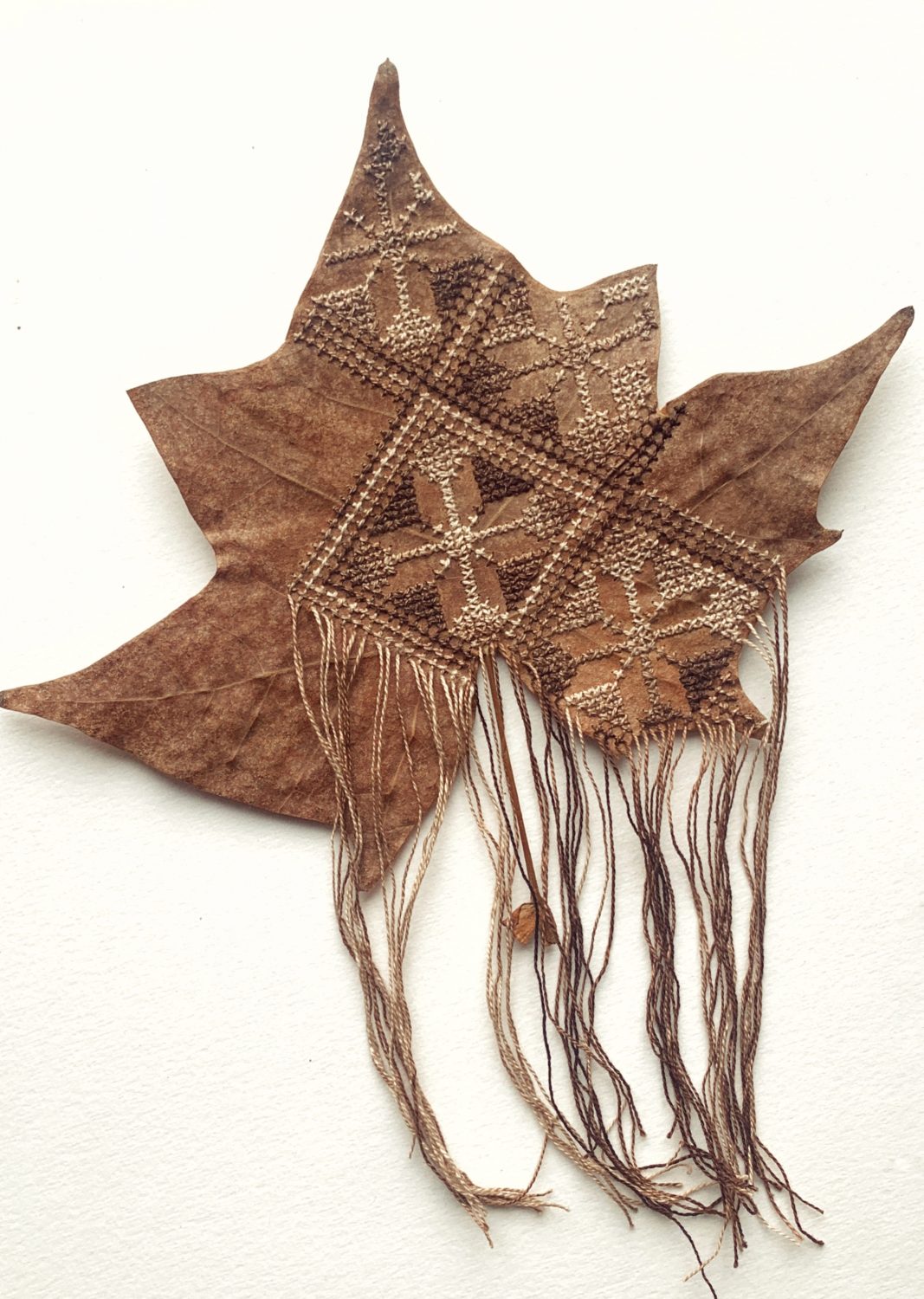The Hand and Lock Embroidery Prize was established back in 2000 to “promote the fine art of embroidery”. The prize brings great exposure to upcoming and well established artists and highlights the innovations of embroidery. There were some incredible winners this year and luckily, we had the opportunity to interview some of them! Today we’re catching up with 2022 3rd place winner of the Student Category in Textile Art, Ellen Anderton.
Describe your Hand & Lock entry and the inspiration behind it.
I was inspired by a few different aspects for my submission to the Hand and Lock prize. Initially I was motivated to create a piece that would evoke a message around responsible design and ocean sustainability. Due to my family recently moving to the Devonshire coast I was surrounded by such amazing visual research and natural forms that I wanted to see how I could recreate them through thread.

As someone who notices colour, the transitions our ocean corals have gone through due to coral bleaching has been an issue I have delved into and hoped to create more awareness on.
The piece therefore has a direct comparison between skeletal coral void of depth, alongside highly rich and vibrant oceanic life; this shows our before and after.
The skeletal corals were created digitally using padloft and aquafilm to create the individual shapes, which then had the colourful pieces on top added through hand techniques. The embroidery emulates the forms of our adapting oceanic life.

3D embroidery and piecing structures together is a part textiles that has always pulled me towards designing. Figuring out how to arrange something is like a jigsaw and extremely rewarding to see the journey from flat pieces to curves and differing levels.
Alongside the process of creating structural embroidery the inspiration behind designing pieces that are raised is due to wanting to create more inclusive embroidery for the visually impaired community. Due to having family members with sight impairments I have always been conscious of the fact that the art industry is heavily sight biased.

Implementing a few design choices can make a big difference to someone trying to see and feel a part of a piece. When touch isn’t allowed then the next best thing is introducing clear outlines for the eye to follow.
Alongside this blocking out colour transitions, raising shapes and using high colour contrasts and thick textures.
Overall, my Hand and Lock entry was a piece that highly informed my wider design knowledge surrounding sustainability and inclusivity, as well as giving me a lot of enjoyment through the additive process of piecing it together.

This has got to be my favourite fact I have learnt about Ellen’s work. Textiles is a beautiful medium because of the tactility of the materials and the connection that can be created through this. Using her work to reach out to the visually impaired community is an inspiring use of Ellen’s well-developed skills in embroidery and beadwork.
Are there any secrets you can now reveal about your entry?
The piece itself looks to be quite planned and perhaps purposeful in its layout. I’ve been asked how I aimed to put it together when really the actual process behind it was completely unplanned!
The embroidery originally began as just a digital construction. I created many different shapes, embroidered them out on the multihead machine and then working on a mannequin pinned, placed and changed them around until I liked the composition that it had of working up the body and around the shoulder. Then I sewed them all together.
The piece was going to stay like that until I became involved in the Fashanne competition. Now I had to consider how this piece would work as a fashion piece rather than a textile sample. Discovering how it would stay on the body and remain held together taught me a lot and influenced changes in threads I used.

This then saw the piece grow slightly so it covered more of the body and had more impact. The piece was then submitted as part of my graduate collection and wasn’t until months later when I entered the Hand and Lock competition that I then added the embellishments on top.
I used small digital shapes leftover from my technique testing and used these and leftover beads to enhance this piece to be what it is now.
Overall, there was no plan with this design, just many months of slow changes until it evolved to what it was. In all honesty it was sometimes hard to keep going back to the same design, but each change made it something different and so I remained inspired by it and motivated.

To hear that Ellen’s entry was mostly unplanned is almost unbelievable seeing how well the piece has come together. The months of work however are clear, the details are so intricate and I particularly love how the piece is layered, revealing other shapes and colours underneath.
The inspiration from the ocean is also evident even upon first glance and the intuition the piece was created with is not to be underestimated. Ellen shows us that our past experiences can accumulate and later be documented through the creation of an artwork. More often than not this creates a brand new living memory.
Leading with your intuition was also a topic we discussed recently with another Hand & Lock winner Eliné Gaude.

Where do you think your creativity is taking you?
Currently I am working as a digital embroiderer and really excited to be learning more around digitising artwork, understanding machine processes and the materials needed to create successful designs. I believe this technical understanding has increased my overall knowledge of embroidery and ways to create high finishes. This understanding has made me a better hand embroiderer as a result, now appreciating the process of slow work and carefully putting needle to fabric.

I have always loved the combination of digital and hand. Optimising digital backgrounds for hand embellishments is something special, the combination of purposeful programmed stitching with the haphazard beautiful imperfections of doing something by hand.
Moving forward with creativity, I aspire to one day be able to pass on my knowledge of my own design approaches to others, whether through teaching or giving talks to embroidery guilds.

I still believe a lot more can be done for inclusivity in our art industry and hope to discover how I can help with this movement and push it forward. There are many steps we can implement within art galleries that can easily involve a part of our community who are not always considered.
I hope to keep up being inspired and motivated by embroidery and combining it with purposeful messages.
What one piece of advice would you offer someone looking to be an artist?
Art can be created through hundreds and thousands of different forms of media. Everyone is unique and different and so when approaching the industry or particular artistic community I think, though it is hard, that staying confident in your own skills and the unique qualities you have to offer is important.
It is easy to become distracted by what others are doing and so focusing on your own passion and not on the noise happening all around you will only add quality to your own work. Collaboration rather than competition is a great way to see your fellow designers, inspiring each other will only help grow your love of the media in which you design with.

Furthermore, imposter syndrome is hugely common and for me personally is hard to ignore. Ways I have helped myself is to really put an effort into making myself aware of the field I am going into.
From seeking out internships, giving talks about embroidery or going to as many exhibitions and craft shows as I can. The more people you meet the less daunting and large the industry feels!
Imposter syndrome is a phrase we come across time and time again in interviews and can be difficult for artists to navigate. Part of being creative is challenging our process. The more confidence we can have as artists, the more risks we can take.

Ellen works through her intuition and understands her work through a different and interactive perspective. The feel and textures of her work are of the upmost importance to ensure the work reaches communities such as the visually impaired. This is a practice we could all integrate into our lives in order to make the work we do accessible to all.
Thank you so much to Ellen for taking the time to interview with us! You can follow Ellen on Instagram or find more about her entry on the Hand & Lock website.







